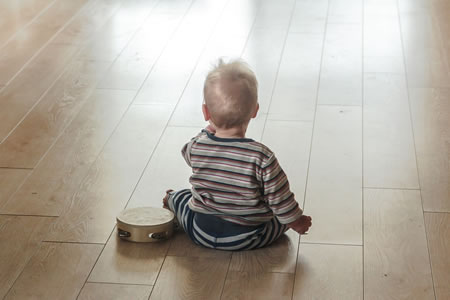Is My Child Musical?
 You may be surprised to learn every child is born a musical human being. Yes, every child!
You may be surprised to learn every child is born a musical human being. Yes, every child!
You don’t need to be a trained educator to recognize musical responses. Musical talent begins in the simplest ways. Parents can easily observe many signs. Recently in a mixed-age class of children, I watched with amazement at the varied musical responses. I observed a quiet eight-month-old, reticent to participate in the first two classes, but at week six is bouncing her body and joining in on egg shaking. Our two-month-old infant is responding to musical activities by joyfully kicking his feet in occasional spurts. Our oldest student, a four-year-old, is continuing classes begun at age one. Responding to music comes naturally to her. She creates new rhythms during our improvised jam sessions and comfortably joins in our musical play with unusual meter.
Many people consider themselves musically unable to help a child. However, you know more than you think! Here are five ways you can help your child or a child in your care reach their fullest musical potential:
1. Sing often! Research shows that placing a child in front of a TV screen doesn’t encourage language development. The same holds true for music. Just as language development happens when a child engages in live, meaningful conversations, music development flourishes with daily, active music-making. Sing a song with your child for bath time, waking up, getting dressed or transitioning from one activity to another. Rock your child to sleep singing a lullaby, creating wonderful memories. At Kids’ MusicRound® we adapt songs for everyday routines. Remember, your voice is the most important voice to your child whether or not it’s on pitch.
2. Dance with abandon! OK, you say you’re not a dancer. It’s not a prerequisite. Turn on the music and shake it! A young child needs to be actively involved in making music. What better way to feel the music and develop beat competence than to kick up those feet and dance away?
3. Bang the pots and pans! Turn on your child’s curiosity, imagination and creativity with household items. Create original accompaniments to the songs you sing. Bring out plastic containers for softer music making or teaching contrasts. If you play an instrument, now is the time to take it out.
4. Rhyme in time! Since rhymes have no melody, this is a great opportunity for children to play with beat and rhythm. Find a horsey chant and bounce your child to the beat on your lap. A great big “Whoa!” at the end always gets lots of smiles. Collect a library of your child’s favorite rhymes.
5. Keep it fun! Whether reciting a rhyme, singing a song or playing prerecorded music, keep the response active. This means rocking, tapping, dancing, swinging, jumping or skipping to the music. During early childhood, children are forming preferences toward or away from various activities. By keeping music fun, your child will develop a love of music.
Every child is born with the ability to make beautiful music. A child’s musicianship develops through active use beginning at birth when musical intelligence is at its highest. Parents have a uniquely central role in developing their child’s musical talent regardless of their own musicality. You can share fun, informal, musical experiences with your child that make a tremendous impact on their musical future, simultaneously igniting their inborn musical talent!
References:
https://www.allianceamm.org/resources_elem_Gordon.html. The Alliance for Active Music Making.
Gardner, Howard. Intelligence Reframed, Multiple Intelligences for the 21st Century. 1999, Howard Gardner. Basic Books, New York, NY.
Begley, Sharon. How to Build a Baby’s Brain. https://www.thedailybeast.com/newsweek/1997/02/28/how-to-build-a-baby-s-brain.html.

